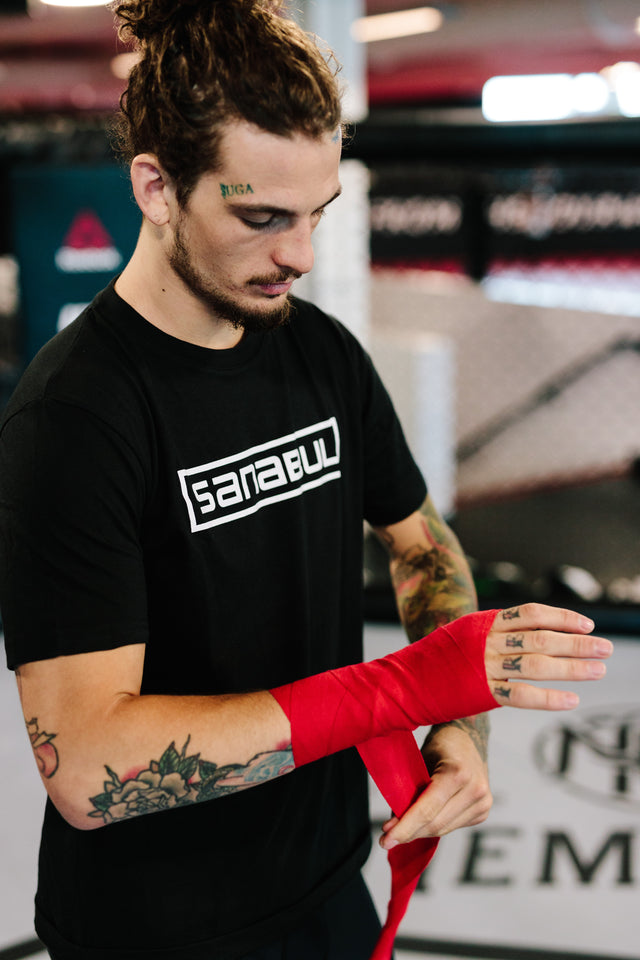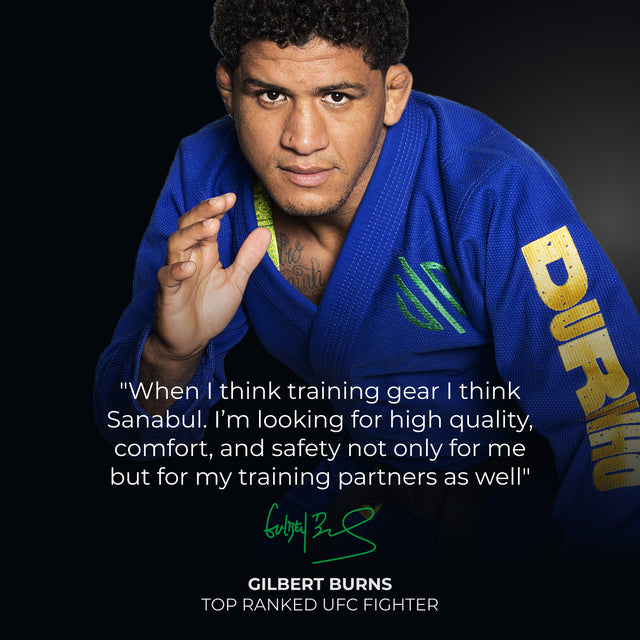Basic Striking: Punching
When it comes to striking in combat sports, there are a variety of strikes that a fighter can have in their arsenal. Punches, kicks, elbows, knees are the most commonly used strikes due to their effectiveness. This article will examine punching.
Here are the first four punches that practitioners will learn when starting out:
- Jab
- Cross
- Hook
- Uppercut
For reference, turning punches/knuckles over is when a fighter will gradually turn their fist in toward their own center line as they throw their punch. They time their punch and fist turn so that these two knuckles are the first to land upon impact with the target. If you have trouble turning punches over, be mindful of your thumb placement. At the end of your punches (after you turn your punches over), your thumb should be the closest finger to the ground.
Jab
The jab is a punch thrown with the lead hand.
When throwing the jab, the fighter will simply extend their lead arm straight out, aiming to connect with the first two knuckles of their fist - the knuckles of the pointer and middle finger. To help ensure that these two knuckles are the first to connect upon impact with their target, fighters often turn their punches over. While turning the knuckles over, the shoulder of the jabbing arm gets raised high enough to cover the chin. After jabbing, the fighter will bring their hand back to their face, to defend potential counter strikes from their opponent. For increased power and reach, the jab is often thrown after the fighter steps toward the target with their lead leg.
When to use: The jab can be used for judging the distance a fighter stands in relation to a target. The jab is also used as a quick strike to close or keep the distance and set up other, more powerful strikes.
Cross
The cross is a punch thrown with the rear hand.
When throwing the cross, the fighter will extend their rear arm straight out, aiming to hit the target with the first two knuckles of their fist. When turning the knuckles over, the shoulder of the punching arm should be raised high enough to cover the chin. Similarly, the back foot will also “turn over”, as it pivots toward the center line of the body as the strike is thrown. This helps to generate more power in the cross, as now the hips and lower body are involved (instead of just the upper body). After throwing the cross, the fighter will bring their hand back to their face, preparing to defend potential counter strikes from their opponent. For increased power and reach, the cross is often thrown after the fighter steps toward the target with their lead leg. The cross is commonly thrown after a different set-up strike that is used to judge the range between a fighter and their target (ex. jab, hook, uppercut).
When to use: The cross can be used as a powerful punch that can cover a large amount of distance and break through an opponent’s guard, based on the penetration step taken by the fighter. It is most effective at medium to long ranges.
Hook
The hook is a punch mainly thrown with the lead hand (but can still be thrown by the rear hand).
When throwing the hook, fighters often turn their body slightly toward their lead hand to loads the lead side. This allows more power to be generated in the strikes coming from this side. After this load, the lead hand will extend slightly away from the body and travel horizontally from one side of the body to the other, aiming to hit the target with the first two knuckles of their fist. The foot on the side of the punching arm will pivot toward the center line of the body as the strike is thrown. This helps generate more power in the hook, as now the hips and lower body become involved. After throwing the hook, the fighter will bring their hand back to their face, to defend potential counter strikes from their opponent. The same mechanics apply to rear hooks, the only difference being the side that everything is done on (lead vs rear).
For increased power and reach, the hook can be thrown after the fighter steps toward the target with their lead leg. However, the hook is designed to be a punch that is most effective when a fighter is close to the target. A hook that connects with a closer target is more powerful that a hook that connects with a target further away. Power can still be generated in longer hooks, but a quick and powerful hook at short-range is when this punch is most powerful. The hook is commonly thrown after a different set-up strike that is used to judge the range between a fighter and their target (ex. jab, cross, uppercut).
When to use: The hook is a powerful punch that is used to land around an opponent’s guard. The hook’s use all depends on the situation, as a short-range hook and a longer-range hook are both very effective punches, when used correctly.
When throwing the hook, some people turn their knuckles over, while others prefer not to. When a fighter is close to the target, they usually do not turn their knuckles over. In the context of a hook, this means that their knuckles are aligned vertically (perpendicular to the ground) and their palm is facing their body when the hook is thrown. When a fighter is a little further away from their target, many turn their knuckles over. When they turn their knuckles over on the hook, their knuckles are parallel with the ground. When turning their hook over, the shoulder of the punching arm should be raised enough to cover the chin. So what’s the right way to throw a hook? Answer: whatever is most comfortable for you and whatever you find works best at the range you throw it at.
Uppercut
The uppercut is a punch mainly thrown by the rear hand, but uppercuts with the lead hand can still be thrown.
When throwing the uppercut, the fighter will slightly turn their body toward their rear side hip to load. Some fighters also drop their rear elbow to their hip (while still keeping their hands up) to load the rear side further and generate more power, but at the moment the elbow dips to the hip, they are more vulnerable to being hit since their hand will drop as their elbow does. After loading, the uppercut is thrown in an upward and somewhat outward motion, aiming to hit the target with the first two knuckles of their fist. How far the uppercut is thrown away from the body will vary, depending on the distance to the target. The back foot will pivot toward the center line of the body as the strike is thrown. This helps generate more power in the uppercut, as now the hips and lower body are involved. After throwing the uppercut, the fighter will bring their hand back to their face, to defend potential counter strikes from their opponent. The same mechanics apply to lead uppercuts, the only difference being the side that everything is done on (rear or lead).
For increased power and reach, the uppercut is often thrown after the fighter steps toward the target with their lead leg. The uppercut is commonly thrown after a different set-up strike that is used to judge the range between a fighter and their target (ex. jab, cross, hook). Like the hook, an uppercut that connects with a target close to the fighter will be more powerful that an uppercut that connects with a target further away. Power can still be generated in longer uppercuts, but a quick and powerful uppercut at short-range is where this punch is best used.
When to use: The uppercut can be used as a powerful punch that can slip under an opponent’s guard. It is commonly thrown at shorter ranges, but can also be thrown over longer distances.
The same principle of the turning over the hook applies to the uppercut. At close-range, the knuckles are usually not turned over. For targets at longer-range, the knuckles will often turn over. Again, this is not a rule, but a preference for each fighter.
Linked below are instructional videos that may help you with your punches. These come from Tony Jeffries, a former Olympic boxing medalist.
How to throw a jab: https://sanabulsports.com/blogs/techniques/boxing-basics-how-to-throw-a-jab-sanabul
How to throw a cross:
How to throw a hook - https://sanabulsports.com/blogs/techniques/boxing-basics-how-to-throw-a-hook-punch-by-tony-jeffries
Thank you for reading - we hope this article effectively covers the basics of punching and gives some insightful tips!





0 Comments
There are no comments for this article. Be the first one to leave a message!